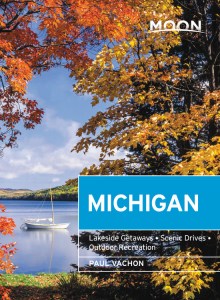Visiting Pictured Rocks National Lakeshore in Michigan
Most people never lose their fascination with beautiful displays of nature. Hugging the Lake Superior coastline for 42 miles, Pictured Rocks National Lakeshore is an archetypical example. Generations of writers, artists, and photographers have been inspired by the colorful hues of its escarpments.

In 1820 the geologist Henry Rowe Schoolcraft visited Picture Rocks and described it as having “some of the most sublime and commanding views of nature.” In 1966 the U.S. Congress saw the need to protect this prized area and established Pictured Rocks National Lakeshore (906/387-3700)—the first such property in the nation—under the authority of the National Park Service.
For a full 15 miles, massive sandstone cliffs tower over the lake, some reaching heights of 200 feet. Because of the multidimensional geology of the area, the colors of various minerals combine with the groundwater to create streaks of red (from iron), yellow-brown (limonite), and pink-green (copper). Other physical features lie within the park’s borders, including sand dunes and waterfalls, but for most visitors, the colorful cliffs are the main attraction. With a few exceptions, however, they can only be viewed from the water.
Mindful of this, local operators offer visitors of all abilities the opportunity to see and enjoy the cliffs. These include boat tours, sea kayaking, and hiking.
Pictured Rocks Cruises (906/387-2379, Memorial Day-mid Oct., $38 adults, $10 ages 6-12, $1 under age 6) offers three-hour trips up the shoreline from Munising, sidling up practically close enough to touch the rock formations while giving you the perspective to comprehend the turreted shapes like Miners Castle. Though trips are offered up to seven times a day, plan for either the late afternoon or Sunset Cruises, when the sinking sun shows off the multicolored sandstone in its best light, providing the best conditions for photographs. The boats depart from the Munising City Pier.
Kayaking offers the skillful paddler-photographer the chance to get some truly remarkable shots from otherwise impossible angles.
Newsletter Signup
By clicking ‘Sign Up,’ I acknowledge that I have read and agree to Hachette Book Group’s Privacy Policy and Terms of Use
Sights in Pictured Rocks National Lakeshore
Munising Falls Area
The highlight of this spot used to be the trail that led hikers behind the 50-foot Munising Falls, but erosion problems prompted its closure. It’s still worth a stop, though, for the falls and the adjacent interpretive center, which offers a glimpse of the history of this peaceful area, home to a belching pig-iron furnace in the 1860s. Munising Falls also marks the west trailhead for the Lakeshore Trail, a 43-mile segment of the North Country Trail that spans seven states from New York to North Dakota. The Lakeshore Trail runs the length of the Pictured Rocks National Lakeshore. Predictably, it never strays far from the water’s edge. The park’s eastern trailhead lies near Sable Falls.
Past Munising Falls, the paved access road ends at Sand Point, home of the National Lakeshore Headquarters (N8391 Sand Point Rd., 906/387-2607). While the headquarters houses offices and not visitor services, it displays some interesting Coast Guard and shipwreck artifacts on its grounds. Sand Point has a small beach and a boat ramp, a good spot to launch a small craft for exploring nearby Grand Island.

Miners Castle
For whatever reason, most people love to describe natural creations using the names of artificial objects. The sandstone cliffs five miles northeast of Munising Falls are known as Miners Castle for the turret-like shapes caused by wind and wave erosion. The nine-story-high rock formation is most impressive and ranks as one of the park’s most popular attractions. Boardwalks and steps lead to two viewing platforms out on the rock, where you can peer down into the gloriously clear waters of Lake Superior. If that entices you to do a little beachcombing and wading, a nearby trail leads down some steps through the pines to the inviting Miners Beach.
To reach Miners Castle, follow County Road H-58 east from Munising to the well-marked turnoff for Miners Castle Road. Before you reach the Miners Castle formation itself, you’ll see another sign on Miners Castle Road directing you to Miners Falls. It’s a fairly easy one-mile walk to these pleasant falls, where Miners Creek tumbles 40 feet over a rocky escarpment.

Chapel Basin Area
Continuing northeast on County Road H-58, the next auto accessible route into the heart of the park is at Melstrand, where the gravel-and-dirt Chapel Road bumps six miles toward the shore and another park highlight, the Chapel Basin area. Park your car here, and you’ll find plenty to entertain you during a long day hike or weekend: three waterfalls, a deep inland lake, Superior beaches, and a good loop hiking trail. Chapel Falls is the key attraction, as evidenced by the 1.5-mile paved pathway that leads to it.
If you turn left instead of right at Chapel Beach, you can make a 10-mile loop around Chapel Basin. Along the way, you’ll pass Grand Portal Point, another significant Pictured Rocks landmark, before returning to the parking area. Don’t leave Chapel Basin without a visit to Mosquito Falls, which is a bit farther inland off Chapel Road. The Mosquito River spills over a series of ledges, creating an accessible waterfall calm enough for wading and soaking fatigued hiking feet. A trail leads to various sections of the falls and links up with the Lakeshore Trail.
Beaver Lake
Located near the center of the park, 800-acre Beaver Lake is the largest inland lake in Pictured Rocks. Anglers are drawn to the lake and the tributaries that feed it, especially for trout. Little Beaver Lake, connected by a small channel, has a boat launch. Boats are limited to 10 hp or less, making this a pleasant waterway for paddlers. Little Beaver also has one of the park’s three auto-accessible campgrounds, with eight sites available on a first come, first served basis. Be aware that wetlands cover much of the terrain between Beaver Lake and Lake Superior, so bugs can be a problem, especially in June and early July.
Lighthouse
It’s a 1.5-mile walk along the Lakeshore Trail from the Hurricane River campground to the Au Sable Light Station at Au Sable Point. Built in 1874, the 87-foot brick light and its keepers did yeoman’s duty for decades—warning ships away from the rock shoals that extend out for nearly a mile and create shallows of just 6 to 30 feet. Nonetheless, at least 10 steamers met their demise here. As you walk the trail from the campground, look for parts of the shipwrecks just offshore, which often poke out of the sandy bottom and are easily visible in the crystal-clear water. The light was automated in 1958.
Several recent restoration projects involved renovating the light keeper’s quarters, rehabilitating the landscape, and installing a photovoltaic (solar-powered) system to power the site. Tours (906/387-3700, 11am-4:30pm Wed.-Sun. July-mid-Aug., $3, free under age 6) are offered.

Grand Sable Dunes
Just east of Au Sable Point, the Log Slide Overlook marks the site of a once busy logging operation. In the late 1800s, loggers used this high point—some 300 feet above Lake Superior—to send freshly cut logs down to the water’s edge, where they were loaded onto Great Lakes schooners. Today, you can stand on a platform and simply marvel at the view, with the lighthouse to the left, the great dunes to the right, and the brilliant blue of the big lake filling the horizon.
Newsletter Signup
By clicking ‘Sign Up,’ I acknowledge that I have read and agree to Hachette Book Group’s Privacy Policy and Terms of Use
Pin For Later


